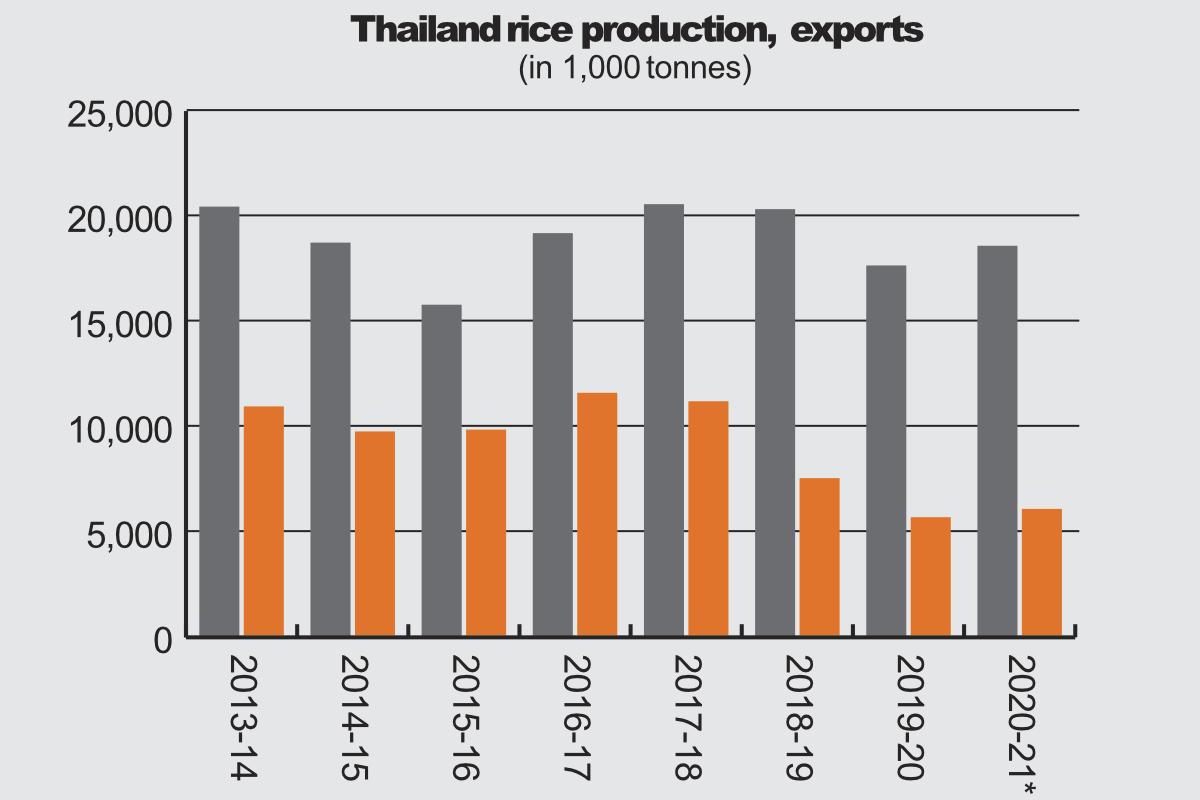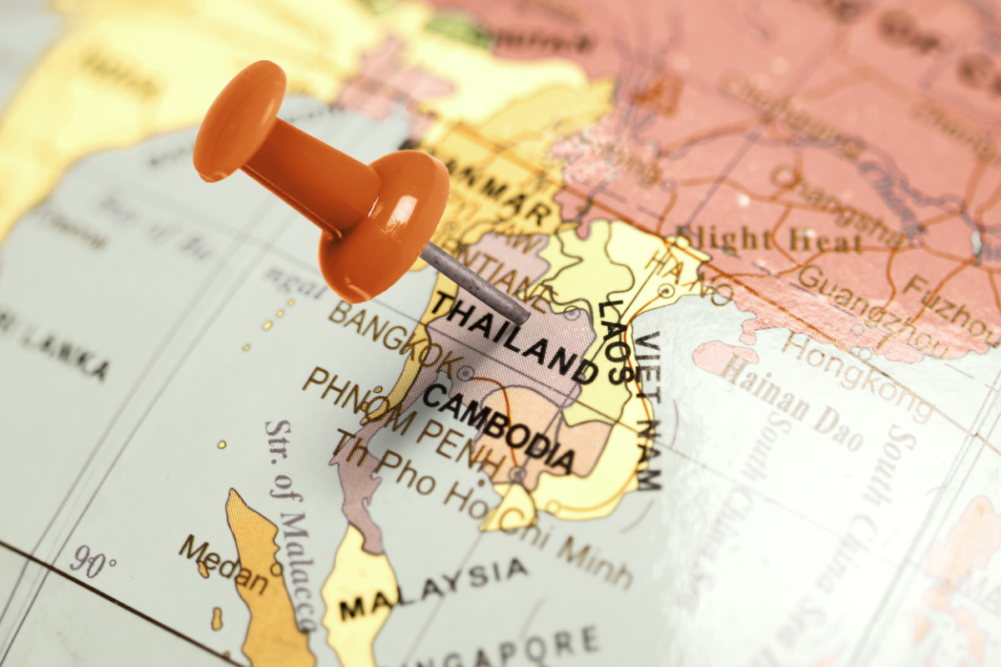Thailand is one of the world’s most important producers of rice, which forms the chief staple of its peoples’ diet, as well as being a major export. After two poor drought-plagued years of production, the country is heading for a big crop just as, it is hoped, recovery from the economic effects of the COVID-19 pandemic sets in and tourists start to return to the country’s hotels and restaurants. Wheat production is small, leaving the milling sector dependent on imports.
The International Grains Council (IGC) puts Thailand’s total grains output in 2020-21 at 5.4 million tonnes, compared with 5.3 million last year. The figure includes 5.3 million tonnes of maize, up from 5.2 million in 2019-20 as well as 100,000 tonnes of sorghum, a figure unchanged from the previous year.
Thailand’s total grains imports in 2020-21 are put at 4.8 million tonnes, compared with 4.7 million the year before. The IGC estimated wheat imports at 3.4 million tonnes, down from 3.6 million in the previous year. Imports of soybeans are put at 4.1 million tonnes in 2020-21, the same level as in the previous year.
Thailand is a major rice producer. For 2020-21, the IGC puts its crop at 18.7 million tonnes, compared with 17.9 million the year before. In terms of rice exports, it is second only to India, at 7.7 million tonnes in 2020-21, compared with 5.8 million the year before.

In an annual report on the grains sector dated March 15, 2021, the US Department of Agriculture attaché forecasts an increase in the country’s rice production to 21 million tonnes in 2021-22.
“This is a 12% increase from 2020-21 due to an expected recovery in main and off-season white rice production,” the report said. “Main and off-season rice production has been adversely affected by drought over the past two years, especially white rice production in irrigated areas.”
Rice is the primary food staple for Thais with per capita consumption ranging from 80 kg for city households to around 155 kg for rural households, the attaché said. A 3% rise in consumption is expected in 2021-22, driven by “an expected recovery in Thailand’s tourism sector, in particular for hotels and restaurants.”
In 2022, the government expects foreign tourists to increase to 23 million, after sharply lower numbers in 2020 and 2021 because of the COVID-19 pandemic. The number of visitors was 39.9 million before the outbreak, falling to 6.7 million in 2020 and a forecast 5.5 million in 2021.
“The recovery in the hotel and restaurant sectors, which account for 6% of GDP, will help boost direct rice consumption and rice-based food consumption, especially for rice noodles, which is made from broken rice,” the attaché said.
“Additionally, broken rice demand in swine feed, which accounts for around 15% of total rice consumption, is expected to continue to grow by 2% in 2022,” the report said. “Exports of live swine to neighboring countries where swine farming was affected by ASF is driving the increase in demand.”
The USDA forecast a rise of 29% to 9 million tonnes in Thailand’s rice exports in 2022, “due to larger exportable supplies and the global economic recovery from the pandemic in 2020 and 2021.”
“Thai rice export prices are expected to be competitive as the price difference between Thai and Vietnamese rice converged during the last quarter of 2020, compared to the price difference of around $50 to $100 per tonne during the first half of 2020,” the report said. “In January 2021, Thai rice exports totaled 400,000 tonnes, down 23% from the same period last year due to a lack of available containers for rice exports. Exporters anticipate that the shipping disruption should ease in the second half of 2021.”
Wheat production is marginal in Thailand due to unfavorable climatic conditions, limited seed development, and unattractive returns compared to other field crops, the attaché said. Total production is estimated at approximately 300 to 400 tonnes on a cultivated area of around 1,000 rai (160 hectares).
“Cultivation is mainly in the upper northern regions of the country as a minor crop after the main-crop rice harvest, particularly in the provinces of Maehongson and Nan,” the attaché said.
Milling sector

In its annual report for 2018, flour miller T S Flour Mill Public Company Ltd. said that, “there are 12 wheat industries in Thailand. Each industry has production capacity around 250 to 1,500 tonnes per day.”
The IGC forecasts Thailand’s 2020-21 wheat flour imports at 170,000 tonnes, up from 162,000 tonnes in 2019-20.
The USDA attaché forecasts a rise of 3% in wheat consumption in 2021-22 because of the expected economic recovery.
“Milling wheat consumption, which accounts for around 47% of total wheat consumption, is expected to increase by 2% from 2020-21 driven by growing demand from baking and food processing in anticipation of gradual recovery in tourism and the domestic economy,” the report said. “Also, feed wheat consumption is expected to increase by 4% from 2020-21 due to continued increase in livestock production, particularly for swine, poultry, and shrimp production.”
Despite the pandemic, wheat consumption is expected to increase by 2% in 2020-21 “due to the growing instant noodle production driven by strong domestic and export demand,” the attaché said. “The increased instant noodle production more than offsets the reduced bakery production, which is usually fueled by Thailand’s tourism sector.”
Dependent on soybean imports
Soybean production in Thailand has been on a downtrend over the past several years due to low yields and unattractive returns when compared to competing crops like corn and off-season rice, the attaché said in an annual report on the oilseeds sector dated April 1, 2020. It forecast production at 52,000 tonnes in 2019-20 and 2020-21.
“Due to low domestic production, Thailand depends almost entirely on imported soybeans to meet domestic demand for animal feed, vegetable oil and food,” the report said. “The Thai government has no clear direction for promoting soybean production in the country. On the one hand, it announces an objective to increase soybean acreage but does not have solid plan or measures to accomplish its goal. On the other hand, the government recently reduced the annual budget for agricultural research centers, affecting researchers developing new high-yield varieties, including soybeans.”
De facto biotech ban
In an Oct. 27, 2020, report, the USDA attaché described Thailand as having a “de facto ban” on the production of genetically modified crops.
“Although there were field trials for several transgenic plant varieties in the 1990s, the Thai government issued a blanket ban in 2003 on further field trials after public opposition,” the report explained. “The Cabinet, however, gave permission for GE crop field trials to be conducted in Thailand under certain restrictions in 2007.”
Despite the change in regulations, no GE crop field trials have been conducted in Thailand since the 2003 ban, the USDA said.
“Monsanto Thailand planned to partner with Naresuan University to conduct a field trial for NK603 herbicide-resistant corn in 2013, but Naresuan University changed course and declined to host the project,” the attaché said. “Syngenta Thailand and Pioneer Thailand have also discontinued their projects to conduct greenhouse trials of GE corn seeds.
“Thai producers, retailers, and consumers remain misinformed about the safety and use of transgenic plants or related foods. Contrary to public perception, Thailand consumes large amounts of biotech crops either directly (such as soybean oil) or indirectly (through the garments and processed foods that use biotech inputs). Although mandatory labeling is required for food products with more than 5% GE content, unpackaged products or products packaged in bulk are exempt from the rules. This has led to public misinformation about the amount of biotech products that they consume.”




